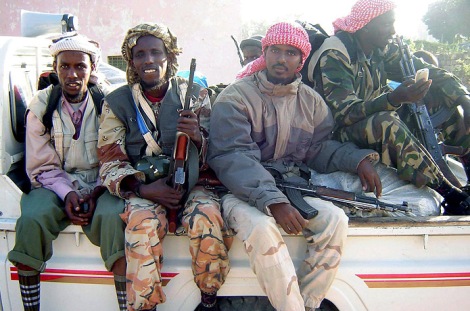
Today, al-Shabaab continues to be on the run, as they continue to be pursued by the Somali National Army (SNA) and its allies in AMISOM.
Though al-Shabaab still controls many small towns, it has lost significant territory overall–including cities such as Beledweyne, Baidoa, and most recently its economic hub of Kismayo, which has deprived it of tens of millions of dollars in revenue from port taxes on commercial activities and easy access to receive military equipment.
As a result, the face of al-Shabaab is changing. Many foreign fighters are fleeing to Yemen or other Jihadi hotspots, the mid-level leadership structure is undergoing changes, and rumors of an official split between Sheikh Hassan Dahir Aweys and his Hizbul Islam fighters from al-Shabaab continues to stew without much detail.
Notably, on 26 October 2012, Sh. Aweys gave an Eid sermon from Baraawe–a port the group still controls–stating, “As you can see, I am an old man. People, die fighting rather than surrendering to the enemy.”
So, while Aweys’s status in al-Shabaab is contested, he continues to play his normal role as a demagogue.
Overall, several news outlets have focused broadly on the weakening aspects of al-Shabaab, but there are still factors that make the group a significant actor in Somalia.
10,000 al-Shabaab Militants Have Not Disappeared
Kenya military sources have alleged that Operation Linda Nchi has killed around 3,000 of the estimated 10, 000 al-Shabaab militants, while stating that only 30 members of the Kenya Defence Forces (KDF) have perished. However, these numbers may be inaccurate because military sources often exaggerate or cannot empirically confirm the number of casualty figures during warfare.More precisely, al-Shabaab has chosen the strategy of “tactically withdrawal” in order to avoid the numbers of casualties that the KDF says that it has incurred on the group.
Setting this aside, the number al-Shabaab attacks have remained consistant throughout South Central Somalia. The map below shows some of the locations (without noting multiple incidents) of al-Shabaab attacks in the last two weeks:

Note: There has been an absence of al-Shabaab attacks in Middle Juba, likely because the group controls most towns in the state.
These attacks are not only against vulnerable patrolling troops. Al-Shabaab also has targeted high-profile individuals, including a top SNA commander (who was killed in an ambush,) popular poet Abwan Warsame Shire Awale (who was gunned down,) and the Bardaale District Commissioner in Baidoa (who survived an ambush).
These developments show that Somalis in the southern part of the country still face a significant threat from al-Shabaab, and even indisciplined SNA/Ras Kamboni troops who have been accused of abuses and looting.
Though the group has less funding, the number and geography of al-Shabaab attacks show that it can execute a cheap insurgency, as it is financially unchained from the costs of governing some of the territories that it has lost.
Al-Shabaab in Puntland and Yemen
Another development from the onslaught against al-Shabaab is the dispersion of its members and activities.Reports for months have indicated that dozens of al-Shabaab have been moving to the Galgala region of Puntland under the leadership of Yasin Kilwe–who controversially replaced Sheikh Said Mohamed ‘Atom’ earlier in 2012.
However, Puntland President Ahmed Farole seems to have neutralized the threat of al-Shabaab in northern Puntland to this point by effectively deploying his security forces and offering amnesty to defectors.
Kilwe’s Galgala militia–with the help of religious ideologue Sheikh Abdiqadir Mumin–has tried to exploit the marginalization of the Warsengeli clan by the majority Majerteen clan government as a recruitment tool, but it is unclear if local communities contribute significant support to the movement.
Puntland is important to al-Shabaab not only as a safe haven and staging ground, but also as a point in the weapons facilitation chain.
Recently, a Yemeni men by the name of Salah Afiif was arrested, tried, and sentenced to death by a Puntland court for attempting to facilitate weapons to al-Shabaab from Yemen to southern Somalia via Puntland.
Yemen is also probably the preferred destination of American Jihadi Abu Mansur al-Amriki–aka Omar Hammami–who would rather take up a role similar to the late Anwar al-Awlaki than remain a persona non grata among al-Shabaab leadership.
Al-Shabaab in Kenya
Mandera, Garissa, and Nairobi are increasingly staging grounds for attacks by al-Shabaab and its sympathizers, who comprise of ethnic Kenyan and Somali Muslims who feel marginalized and targeted by the Kenyan government.Al-Shabaab has been reaching this audience through messages from its coordinator for Kenya operations Sheikh Ahmad Iman Ali and through its Swahili-language propaganda magazine Gaidi Mtaani (meaning “Street Terrorist.”)
Though it’s unclear how these messages are being received, Kenyan police are discovering more caches of grenades, arms, and materials for suicide attacks in residential areas.
There were also violent protests in Nairobi and Mombasa after the controversial death of radical cleric Aboud Rogo Mohamed, who many suspect was extrajudicially killed (in front of his family) by Kenyan security forces.
Though Rogo certainly was responsible for planning violent attacks in Kenya, many Muslims interpreted his killing as another example of how Muslims are being targeted in the country.
It is this sentiment that may fuel future extremism in Kenya in the future. Signs of this were present in the demonstrations to protest Rogo’s death, in which a protestor threw a grenade at Mombasa policemen–killing 2 and injuring 15.
Big Picture
It is clear that al-Shabaab is not going away in the near term. The group is merely changing tactics and strategies to fit its resources and advantages.Al-Shabaab will continue to exploit the political context of the region–whether it be the ineffectiveness and corruption of the Somali government or the treatment of Muslims in Kenya–meaning that the ball in many ways is in Kenya and Somalia’s court.
http://somalianewsroom.com/2012/10/31/al-shabaabs-changing-state-in-somalia/




No comments:
Post a Comment